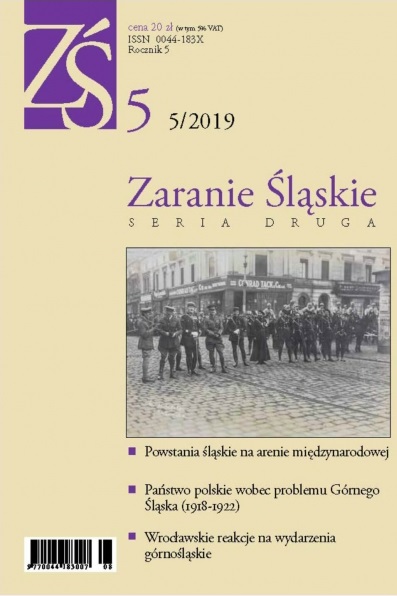Czechoslovakia on the question of border formation in Upper Silesia after WWI: An outline of the problem
Abstract
The way Czechoslovakia approached the problem of borders in Silesia after the
First World War was influenced first and foremost by its conflict with Poland over
Cieszyn Silesia, whose possession it regarded as its top priority. The territorial
claims Prague made were however gradually dropped as the Polish-German
conflict over Upper Silesia developed. The Czechoslovak government supported a
minimal plan which involved incorporating Czech villages in the Kłodzko Land, as
well as the Racibórz region in Upper Silesia and the outskirts of Bohumin. Faced by the deterioration of relations between Poland and Germany in May 1919 and the
prospect of an armed conflict in Upper Silesia, Czechoslovakia decided to remain
neutral in the possible Polish-German war and focused its effort on preparing
documents for the conference of ambassadors which was to determine the fate
of Cieszyn Silesia. On 28 July 1920 Cieszyn Silesia, Orava and Spiš were finally
divided. Czechoslovakia was highly satisfied with the decision. While Prague
showed restraint in its response to the outbreak of the Second Silesian Uprising, it
condemned the following ones. However, after the third Upper Silesian revolt the
Czechoslovak approach to the question of Upper Silesia had changed - Edvard
Beneš decided to support the French proposal and even managed to convince Lord
Curzon that the French solution had numerous advantages.
Downloads
Published
Issue
Section
License

This work is licensed under a Creative Commons Attribution-NonCommercial-NoDerivatives 4.0 International License.
Since transitioning to a digital format, the journal has been operating under open access, meaning all content is freely available to users and institutions.
In issue 8 (2022), published articles are licensed under the Attribution 4.0 International (CC BY 4.0) license.
The full license text is available at: https://creativecommons.org/licenses/by/4.0/legalcode.
Since issue 9 (2023), published articles are licensed under the Attribution-NonCommercial-NoDerivatives 4.0 International (CC BY-NC-ND 4.0) license.
The full license text is available at: https://creativecommons.org/licenses/by-nc-nd/4.0/legalcode.pl.



